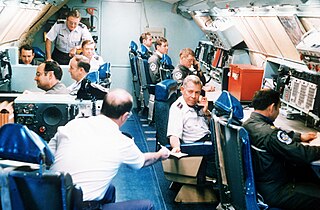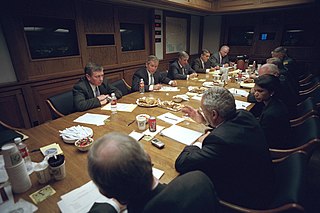 W
WThe United States Air Force's 2d Airborne Command and Control Squadron was an airborne command and control unit located at Offutt Air Force Base, Nebraska. The squadron was an integral part of the United States' Post Attack Command and Control System, performing the Operation Looking Glass mission with the Boeing EC-135 aircraft.
 W
WAllegany Ballistics Laboratory (ABL) located in Rocket Center, West Virginia, is a diverse industrial complex employing some 1,000 people across 1,628 acres (6.59 km2). The facility is a member of the Federal Laboratory Consortium and is operated by Alliant Techsystems (ATK) under contract with the Naval Sea Systems Command (NAVSEA).
 W
WThe Boeing E-4 Advanced Airborne Command Post (AACP), the current "Nightwatch" aircraft, is a strategic command and control military aircraft operated by the United States Air Force (USAF). The E-4 series are specially modified from the Boeing 747-200B for the National Emergency Airborne Command Post (NEACP) program. The E-4 serves as a survivable mobile command post for the National Command Authority, namely the President of the United States, the Secretary of Defense, and successors. The four E-4Bs are operated by the 1st Airborne Command and Control Squadron of the 595th Command and Control Group located at Offutt Air Force Base, near Omaha, Nebraska. An E-4B when in action is denoted a "National Airborne Operations Center".
 W
WCamp David is the country retreat for the president of the United States. It is located in the wooded hills of Catoctin Mountain Park, in Frederick County, Maryland, near the towns of Thurmont and Emmitsburg, about 62 miles (100 km) north-northwest of the national capital city of Washington, D.C. It is officially known as the Naval Support Facility Thurmont. Because it is technically a military installation, the staffing is primarily provided by the Seabees, Civil Engineer Corps (CEC), the United States Navy and the United States Marine Corps. Naval construction battalions are tasked with base construction and send detachments as needed.
 W
WThe Cheyenne Mountain Complex is a Space Force installation and defensive bunker located in unincorporated El Paso County, Colorado, next to the city of Colorado Springs, at the Cheyenne Mountain Space Force Station, which hosts the activities of several tenant units. Also located in Colorado Springs is Peterson Space Force Base, where the North American Aerospace Defense Command (NORAD) and United States Northern Command (USNORTHCOM) headquarters are now located.
 W
WConstruction of the Cheyenne Mountain Complex began with the excavation of Cheyenne Mountain in Colorado Springs, Colorado on May 18, 1961. It was made fully operational on February 6, 1967. It is a military installation and hardened nuclear bunker from which the North American Aerospace Defense Command was headquartered at the Cheyenne Mountain Complex. The United States Air Force has had a presence at the complex since the beginning, the facility is now the Cheyenne Mountain Air Force Station, which hosts other military units, including NORAD.
 W
WDetachment Hotel is the name used to refer to a small 1,500-square-foot (140 m2) bunker complex on Peanut Island, Florida. It was originally designed for use by the President of the United States, specifically John F. Kennedy, in the event of a nuclear war. Constructed in 1960, the bunker was closed less than three years later, and its existence was declassified in 1974. From 1998 to 2017, it was open to the public as an historic site.
 W
WThe District of Columbia Protective Services Division is a division of the Department of General Services of the District of Columbia Government. The organization is responsible for "law enforcement activities and physical security of all properties owned, leased or otherwise under the control of the Government of the District of Columbia."
 W
WThe Federal Emergency Management Agency (FEMA) is an agency of the United States Department of Homeland Security (DHS), initially created under President Jimmy Carter by Presidential Reorganization Plan No. 3 of 1978 and implemented by two Executive Orders on April 1, 1979. The agency's primary purpose is to coordinate the response to a disaster that has occurred in the United States and that overwhelms the resources of local and state authorities. The governor of the state in which the disaster occurs must declare a state of emergency and formally request from the President that FEMA and the federal government respond to the disaster. The only exception to the state's gubernatorial declaration requirement occurs when an emergency or disaster takes place on federal property or to a federal asset—for example, the 1995 bombing of the Alfred P. Murrah Federal Building in Oklahoma City, Oklahoma, or the Space Shuttle Columbia in the 2003 return-flight disaster.
 W
WThe Greenbrier is a luxury resort located in the Allegheny Mountains near White Sulphur Springs in Greenbrier County, West Virginia, in the United States.
 W
WMain Core is an alleged American government database containing information on those believed to be threats to national security.
 W
WThe Mount Weather Emergency Operations Center is a government command facility in the U.S. Commonwealth of Virginia, used as the center of operations for the Federal Emergency Management Agency (FEMA). Also known as the High Point Special Facility (HPSF), its preferred designation since 1991 is "SF."
 W
WThe National Audiovisual Conservation Center, also known as the Packard Campus for Audio-Visual Conservation, is the Library of Congress's audiovisual archive located inside Mount Pony in Culpeper, Virginia.
 W
WThe National Emergencies Act (NEA) is a United States federal law passed to end all previous national emergencies and to formalize the emergency powers of the President.
 W
WThe National Emergency Training Center (NETC) serves as an interagency emergency management training body for the United States government. The college campus was purchased by the U.S. Government in 1979 for use as the National Emergency Training Center. NETC is home to the National Fire Academy, United States Fire Administration, Emergency Management Institute (EMI), which is operated by the Directorate of Preparedness branch of the Federal Emergency Management Agency (FEMA). The campus also includes the learning resource center (LRC) library, the National Fire Data Center, and the National Fallen Firefighters Memorial.
 W
WThe National Military Command Center (NMCC) is a Pentagon command and communications center for the National Command Authority. Maintained by the Department of the Air Force as the "DoD Executive Agent" for NMCC logistical, budgetary, facility and systems support; the NMCC operators are in the Joint Staff's J-3 (Operations) Directorate. "The NMCC is responsible for generating Emergency Action Messages (EAMs) to missile launch control centers, nuclear submarines, recon aircraft and battlefield commanders".
 W
WNational Response Scenario Number One is the United States federal government's planned response to a nuclear attack. It is one of the National Response Scenarios developed by the United States Department of Homeland Security, considered the most likely of fifteen emergency scenarios to impact the United States. The Scenarios are related to the National Response Framework (NRF), which describes the structures and mechanisms of a response and the National Incident Management System (NIMS) that gives a framework to orchestrate emergency management.
 W
WThe Nevada National Security Site, known as the Nevada Test Site (NTS) until August 23, 2010, is a United States Department of Energy (DoE) reservation located in southeastern Nye County, Nevada, about 65 miles (105 km) northwest of the city of Las Vegas. Formerly known as the Nevada Proving Grounds, the site was established on January 11, 1951 for the testing of nuclear devices, covering approximately 1,360 square miles (3,500 km2) of desert and mountainous terrain. Nuclear weapons testing at the Nevada Test Site began with a 1-kiloton-of-TNT (4.2 TJ) bomb dropped on Frenchman Flat on January 27, 1951. Over the subsequent four decades, over one thousand nuclear explosions were detonated at the NTS. Many of the iconic images of the nuclear era come from the NTS. NNSS is operated by Mission Support and Test Services, LLC.
 W
WThe third USS Northampton (CLC-1) was a US Navy command light cruiser. She was laid down as an Oregon City-class heavy cruiser (CA–125), on 31 August 1944 by the Fore River Yard, Bethlehem Steel Corp., Quincy, Massachusetts. Work suspended between 11 August 1945 and 1 July 1948; she was launched as CLC–1, on 27 January 1951; sponsored by Mrs. Edmond J. Lampron; and commissioned as CLC–1, on 7 March 1953, Captain William D. Irvin in command.
 W
WNumber One Observatory Circle is the official residence of the vice president of the United States. Located on the northeast grounds of the U.S. Naval Observatory in Washington, D.C., the house was built in 1893 for the observatory superintendent. The chief of naval operations (CNO) liked the house so much that in 1923 he took over the house for himself. It remained the residence of the CNO until 1974, when Congress authorized its transformation to an official residence for the vice president, though a temporary one. It is still the "official temporary residence of the vice president of the United States" by law. The 1974 congressional authorization covered the cost of refurbishment and furnishing the house.
 W
WStrategic Air Command (SAC) was both a United States Department of Defense (DoD) Specified Command and a United States Air Force (USAF) Major Command (MAJCOM), responsible for Cold War command and control of two of the three components of the U.S. military's strategic nuclear strike forces, the so-called "nuclear triad", with SAC having control of land-based strategic bomber aircraft and intercontinental ballistic missiles or ICBMs.
 W
WThe Post Attack Command and Control System (PACCS) was a network of communication sites for use before, during and after a nuclear attack on the United States. PACCS was designed to ensure that National Command Authority would retain exclusive and complete control over US nuclear weapons. Among other components, it included Strategic Air Command assets such as the Looking Glass aircraft and mission, and various hardened command and control facilities.
 W
WPost-Attack Command and Control System Facility, Hadley is a defunct Post-Attack Command and Control System facility that operated from June 2, 1958 until 1970. It is located on and under Bare Mountain in Hadley, Massachusetts. The facility was known by many different names: 8th Air Force Combat Operations Center (COC), "The Notch", and "Westover Communications Annex" since it was related to nearby Westover Air Force Base.
 W
WThe Presidential Emergency Operations Center is a bunker-like structure underneath the East Wing of the White House. It serves as a secure shelter and communications center for the President of the United States and others in case of an emergency.
 W
WThe United States presidential line of succession is the order in which officials of the United States federal government assume the powers and duties of the office of president of the United States if the incumbent president becomes incapacitated, dies, resigns, or is removed from office. The order of succession specifies that the office passes to the vice president; if the vice presidency is simultaneously vacant, or if the vice president is also incapacitated, the powers and duties of the presidency pass to the speaker of the House of Representatives, president pro tempore of the Senate, and then Cabinet secretaries, depending on eligibility.
 W
WProject Greek Island was a United States government continuity program located at the Greenbrier hotel in West Virginia. The facility was decommissioned in 1992 after the program was exposed by The Washington Post.
 W
WThe Raven Rock Mountain Complex (RRMC), also known as Site R, is a U.S. military installation with an underground nuclear bunker near Blue Ridge Summit, Pennsylvania, at Raven Rock Mountain that has been called an "underground Pentagon". The bunker has emergency operations centers for the United States Army, Navy, Air Force and Marine Corps. Along with Mount Weather Emergency Operations Center in Virginia and the Cheyenne Mountain Complex in Colorado, it formed the core bunker complexes for the US Continuity of Government plan during the Cold War to survive a nuclear attack.
 W
WTysons Corner Communications Tower, also known as Site E, is a classified United States military microwave tower located in Tysons Corner, Virginia. The tower is administered by the United States Army from Fort Belvoir.
 W
WUnited States civil defense refers to the use of civil defense in the history of the United States, which is the organized non-military effort to prepare Americans for military attack. Late in the 20th century, the term and practice of civil defense fell into disuse. Emergency management and homeland security replaced them.
 W
WWarrenton Training Center (WTC) is a classified United States government communication complex located in the state of Virginia. Established in 1951, it comprises four discrete stations located in Fauquier and Culpeper counties.
 W
WThe basement of the White House, the Washington, D.C. residence and workplace of the President of the United States, is located under the North Portico and includes the White House carpenters' shop, engineers' shop, bowling alley, flower shop, and dentist office, among other areas.
 W
WThe White House to Treasury Building tunnel is a 761-foot (232 m) subterranean structure in Washington, D.C. that connects a sub-basement of the East Wing of the White House to the areaway which surrounds the United States Treasury Building. It was originally constructed in 1941 to allow the evacuation of the president from the White House to underground vaults inside the Treasury in the event of an emergency.
 W
WUSS Wright (CVL-49) was a Saipan-class light aircraft carrier of the U.S. Navy, later converted to the command ship CC-2. It is the second ship named "Wright". The first Wright (AV-1) was named for Orville Wright; the second honored both Wright brothers: Orville and Wilbur.